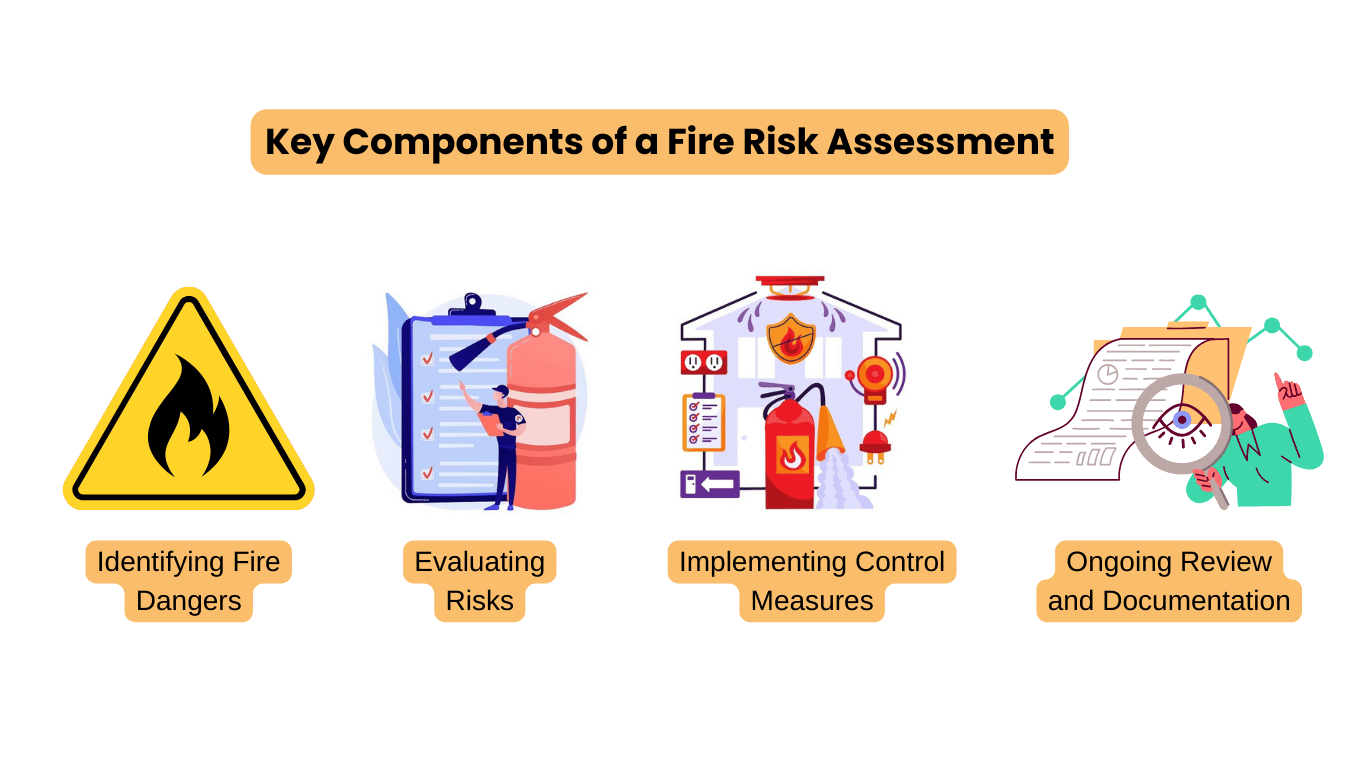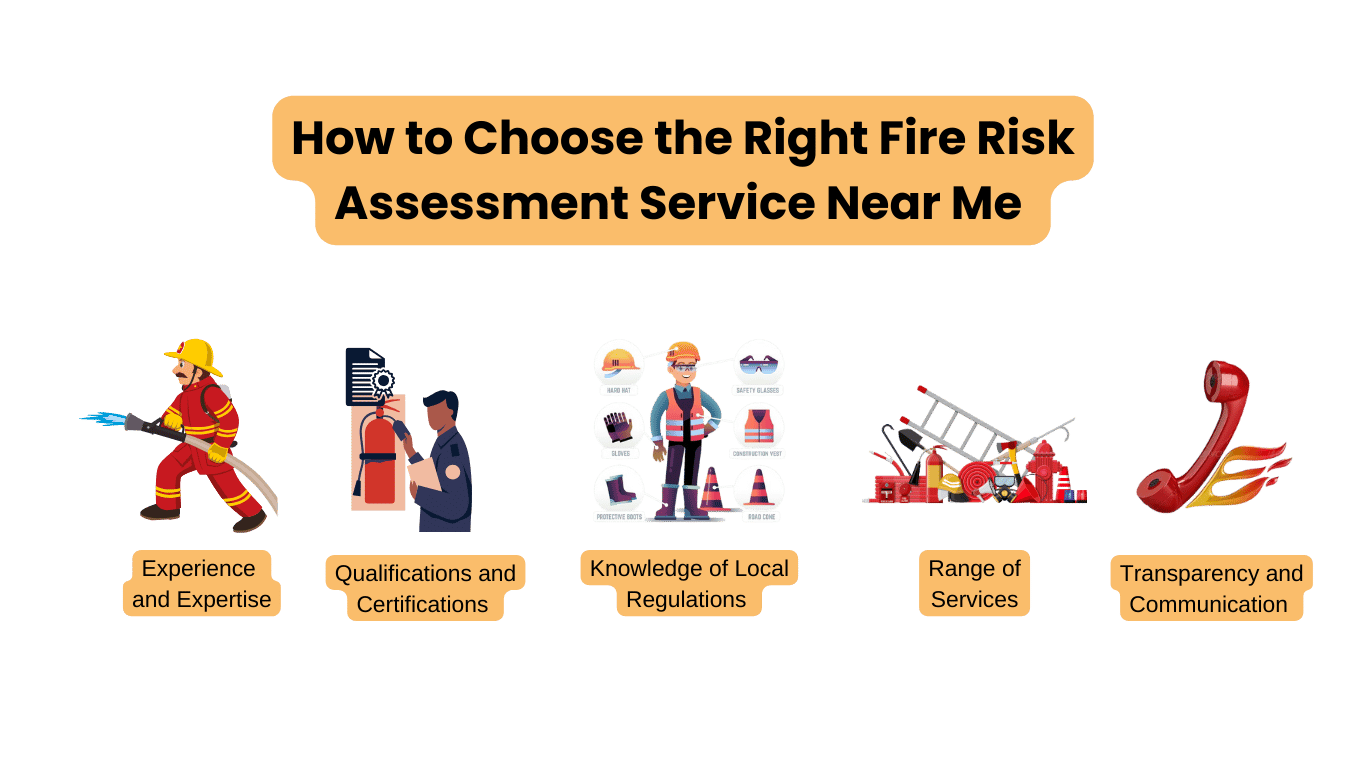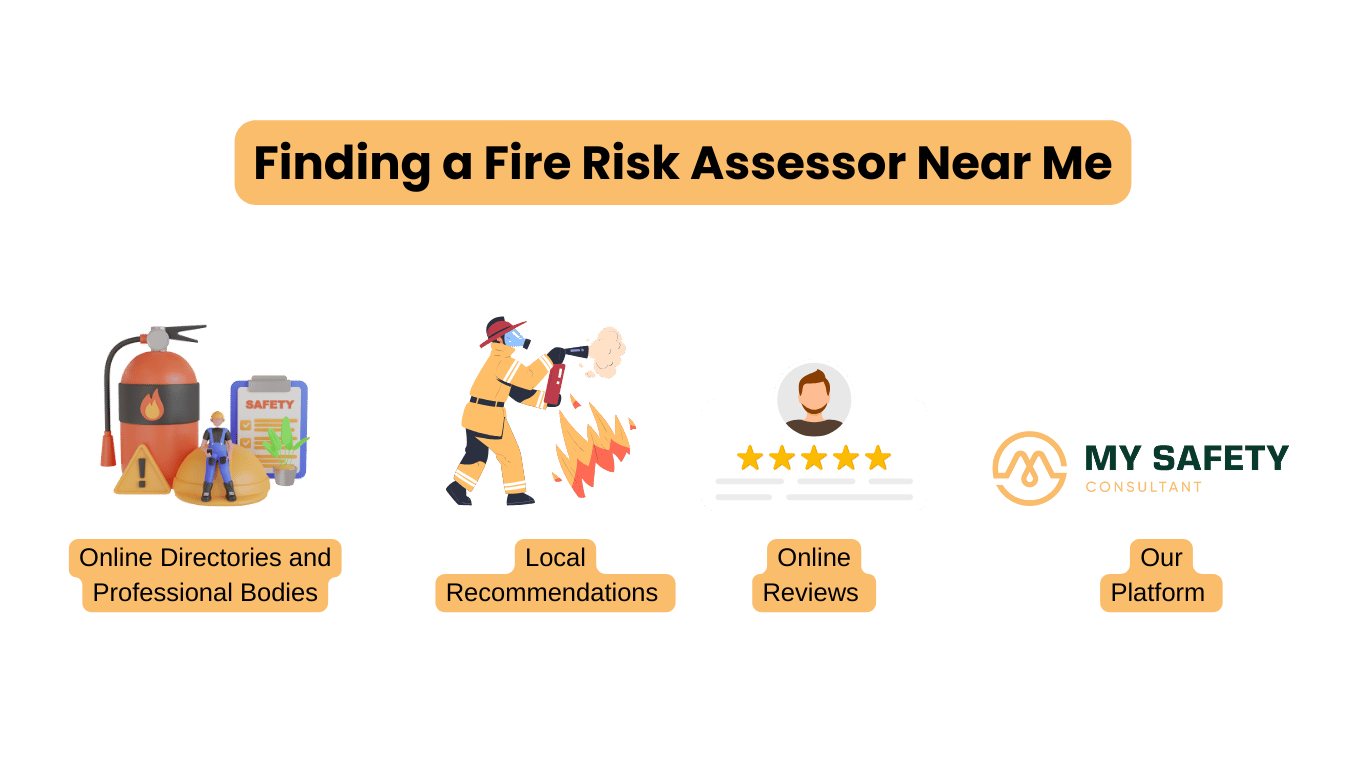How to Choose the Right Fire Risk Assessment Service Near Me

Related Posts




 Health and Safety Act: 50 Years CelebrationAug 8, 2024
Health and Safety Act: 50 Years CelebrationAug 8, 2024
Introduction
Picking the right fire risk assessment service near me is key to making sure your business stays safe and follows all the necessary safety rules. This service helps you spot potential fire hazards, understand how risky they are, and take steps to lower those risks. Choosing the best fire risk assessor near me is challenging, though, because there are many options accessible to this. This article guides you in choosing the best services as per your company's needs.
What involves in Fire Risk Assessment?
A thorough examination of the premises to identify fire hazards, the chances of causing fire, and determine the potential impact, this complete process is considered a fire risk assessment. This also involves suggesting measures to reduce or eliminate the identified risks.
Key Components of a Fire Risk Assessment

- Identifying Fire Dangers: This involves looking for ignition sources, explosive things, and anything else that could cause the spread of a fire.
- Evaluating Risks: determining the severity and likelihood of possible fire events.
- Implementing Control Measures: Recommending activities to reduce recognised hazards, such as installing fire alarms or establishing clear exit routes.
- Ongoing Review and Documentation: Monitoring and updating assessment records as needed, especially after major property changes.
4 Types of Fire Risk Assessments
Fire Risk Assessments (FRAs) assist in identifying possible fire dangers and identifying the appropriate level of fire safety measures to ensure the safety of buildings and their occupants. In the context of apartment towers, there are four unique types of FRAs, each with various degrees of intrusion. Understanding these sorts can help building managers and inhabitants understand the significance of these inspections and when more invasive examinations are required.
Type 1 Fire Risk Assessments
Type 1 FRA is the most prevalent and is usually sufficient for most purpose-built blocks of flats and conversions. This non-destructive inspection focuses primarily on the building's common areas, such as corridors, stairwells, and shared facilities.
Type 1 assessments are usually sufficient unless there is reason to assume serious fire safety hazards that aren't obvious. In some circumstances, the results of a Type 1 assessment may lead to recommendations for further study.
Type 2 Fire Risk Assessments
Type 2 assessments are similar to Type 1 but include an element of destructive sampling. This means parts of the building may be opened up to examine hidden elements that could pose a fire risk.
Type 2 assessments are not standard and are usually only conducted when there's evidence suggesting severe underlying issues, such as compromised fire compartmentation that could allow a fire to spread unchecked.
Type 3 Fire Risk Assessments
Type 3 FRAs go a step beyond Type 1 by including an evaluation of individual flats as well as common areas. Like Type 1, this assessment is non-destructive but covers more ground, looking into the internal aspects of flats, especially areas concerning means of escape and compartmentation.
These assessments are particularly relevant if there's suspicion of fire risks within the flats themselves. However, they can be challenging to arrange, especially in leaseholder flats, due to issues of access and tenant cooperation.
Type 4 Fire Risk Assessments
The most comprehensive and invasive, Type 4 FRAs include destructive assessments of both common areas and individual flats. This type of assessment is exhaustive and usually undertaken only in exceptional circumstances where there's a high suspicion of hidden fire hazards.
Type 4 assessments are generally reserved for situations where other types of FRAs indicate significant potential fire safety issues due to the invasive nature, that need further exploration.
Choosing the Right Fire Risk Assessment Services
When looking for a fire risk assessor, you need to examine many aspects to guarantee you select the correct individual.

- Experience and Expertise
Experience is essential. A fire risk assessor must be a skilled, experienced, and have a track record of completing strict fire safety evaluations. Their experience allows them to deliver unique insights and practical solutions based on your business needs. - Certifications and Qualifications
Assure that the fire assessor has the necessary qualifications and certifications. Obtaining authorisation from British associations such as the Institution of Fire Engineers (IFE) or NEBOSH Fire Safety and Risk Management certificate is important. These credentials attest to the assessor's suitability for performing an exhaustive fire risk assessment. - Knowledge of Local Regulations
A fire risk assessor near me should be knowledgeable about local building standards and fire safety requirements. This local expertise is crucial since it guarantees that the evaluation follows all applicable laws and standards. - Range of Services
Consider if the assessor or organisation provides any further services, such as fire safety training, emergency preparation, or fire extinguisher maintenance. A complete service package can make the procedure easier while also covering all of your fire safety needs. - Transparency and Communication
Clear communication is essential. Your fire risk assessor should explain the findings and recommended actions straightforwardly. Transparency about costs and timelines is also crucial to avoid any surprises.
The Importance of Fire Risk Assessors
Fire risk assessors utilise risk-reduction approaches to identify potential hazards and ensure the building's safety and compliance. Fire assessors are classified into three levels based on their training and expertise.
Tier 1 - Entry Level Register

Qualifications and Skills: Tier 1 fire risk assessors are typically at the early stages of their careers. They have the basic knowledge and skills fit for assessing simple or less complex buildings. They may have completed introductory training courses and often work under the guidance of more experienced assessors.
Tier 2 - Competent Fire Risk Assessors Register (CFRAR)

Qualifications and Skills: Tier 2 assessors have progressed beyond the entry-level stage. They've undergone mentoring and completed examinations conducted by professional institutes, proving their competency in handling more complex assessments. These people specialise in specific sectors, such as heritage buildings, where expert knowledge and abilities are necessary.
Tier 3: The Nationally Accredited Fire Risk Assessors Register (NAFRAR).

These professionals attained the highest levels of knowledge after passing rigorous examinations and getting accreditation from independent third-party organisations. They have good knowledge and are well-equipped to evaluate the most complex and risky assets.
Finding a Fire Risk Assessor Near Me
Here are some tips to help you find a qualified fire risk assessor near me:

- Online Directories and Professional Bodies
Check online directories or websites of professional organisations like the IFE or the Fire Risk Assessors Certification Scheme (FRACS). These platforms often list certified assessors, making it easier to find reputable professionals. - Local Recommendations
Recommendations from other business owners or members of local business groups help as a reference. Personal referrals give valuable insights into the reliability and quality of service of the assessor. - Online Reviews
Look at online reviews and testimonials to gauge the reputation of potential assessors. Platforms like Google Reviews and Trustpilot can provide helpful feedback from previous clients. - Our Platform
Our platform is a connection of businesses with top-tier safety professionals. You easily get an experienced and professional fire risk assessor with the necessary qualifications and local knowledge, with the best service for your specific needs.
Conclusion
Selecting the appropriate fire risk assessment service near me is important for your company's safety and compliance. A fire risk assessor helps to ensure your workplace is safe and meets all legal standards by taking into account aspects such as experience, credentials, and local expertise. Our website simplifies the process by linking you with skilled individuals who can provide full fire safety services.
Get your fire risk assessment today and take a proactive approach to a safer corporate environment. Join our community and find the best fire risk assessors near me to keep your workplace safe and compliant.
FAQs
- When should we review a fire risk assessment?
Fire risk assessment should be reviewed after significant changes like building renovations or new equipment installations and regularly - What to do if the assessment identifies high-risk areas?
Safety measures should be implemented as soon as possible for high-risk areas. New safety equipment, updating fire safety protocols, or making structural changes are to be installed. - Is it necessary to undertake a fire risk assessment?
According to the law, some organisations must do frequent fire risk assessments to comply with safety rules. - Can I perform a fire risk assessment myself?
A basic risk assessment can be conducted, but it's always good to have a professional fire risk assessor near me. As they are professionals, they identify risks you might overlook and provide more comprehensive safety recommendations. - A fire risk assessment takes how much time?
The fire assessment duration depends on the size and complexity of your property. A small business needs only a few hours, while a large or more complex site takes a day or more.
